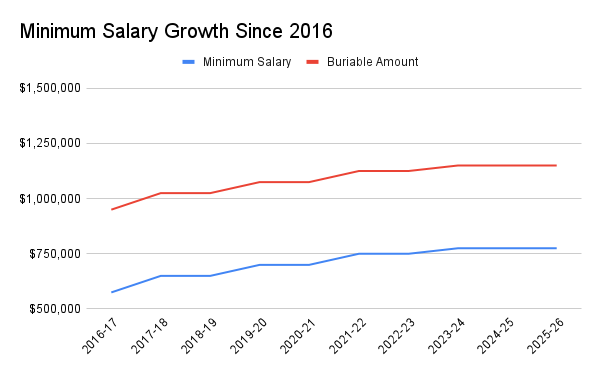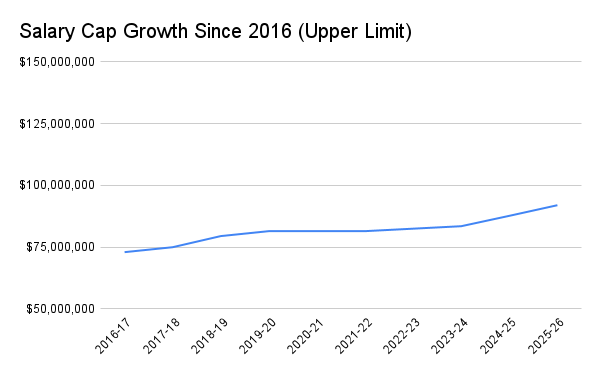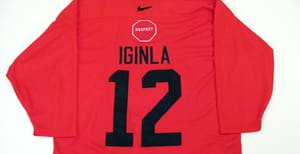Someone mentions a player the Leafs should sign in free agency and the result is always the same: guesses about their contract amount that are significantly below reality and horror when the likely numbers get reported. It's been the same way for years. Hockey fans have been so fixed in their thinking around the formerly flat cap and Leafs fans on the minimal cap space left over after the core five players are accounted for, that they think $3 million is expensive.
This is about to get worse.
Now, let's talk about cars. Picture a car, any car.

Imagine yourself behind the wheel, driving around the racetrack real fast. Speed around. Now go faster, which you may be aware, you achieve by pushing down the aptly named accelerator.
Speed is how fast you're going. Acceleration is the rate at which your speed increases. Now that all seems super obvious, and you know this, and yet talk about inflation today and a large number of people want to redefine it as prices higher than in the before time.
Speed is the price. Acceleration is inflation. Don't mix them up. Higher prices mean there has been inflation in the past, inflation now is about future prices.
Cap Inflation
Now back to the salary cap. The flat cap years came after a period of salary cap inflation, and now we're about to embark on a new one. Prices did rise, and they are now going to rise again.


The external pressures on salaries, which we always think of as the AAV of a contract or its "cap hit", are both the minimum salary and the upper limit of the cap. The charts above show the price and the inflation of salaries and the salary cap since the Leafs got serious and through to the end of the current CBA. The two final years of cap numbers are both estimates. Next year's number won't be finalized for sure until later in June, but the $87.7 million is likely what it will be. The 2025-2026 upper limit is going to be $92 million give or take.
The total inflation in the salary cap is 26% over this period. In 2016-2017, Jonathan Toews and Patrick Kane each had a cap hit of $10.5 million and that led the NHL. Anze Kopitar was the only other player at $10 or over. Sidney Crosby, who led the league in goals with 44 (remember who was second?) had a cap hit of $8.7 million.
Next year's extension for Auston Matthews puts him at $13.25 million or an increase of 26% over Toews and Kane. By 2025-2026 Leon Draisaitl may well be making more than Matthews and the top salary inflation will have actually outstripped the upper limit inflation by a titch.
If, and this is naturally a big if and everyone understands that, but if the NHL revenue continues to grow as projected, the salary cap should continue to rise under the new CBA when that is brought in. Right now the increases are capped at around 5%, but in the next CBA, anything is possible.
Meanwhile, the minimum salary grew at a rate of 35% over this period as the NHL and NHLPA were recognizing that that number was artificially low considering the growth that had happened after the last lockout. The flat $775,000 that will run through 2026 is likely to go up. This is actually more meaningful for the buriable amount, which is tied to the minimum salary in this CBA, a calculation unlikely to change in the next one.
Notwithstanding the occasional "help the home team" deal, players are going to expect their salaries to go up by default, despite their own play. They will expect to benefit from the inflation of the past (the jump from this season to the one that starts in a month), and then they'll talk about a raise on merit on top of that.
Far beyond the "no one is taking a pay cut" lesson, it's time to accept that most players are not settling for status quo either, no matter the circumstances.
Spending Cap Dollars
Let's speed over to the defenceman store and buy a new one. Let's think big, and go for an experienced top-pairing defender. What's it going to cost (in cap hit)?
Morgan Rielly makes $7.5 million on a deal that took effect in 2022. CapFriendly gives percentages based on when the contract was signed, so I'm using that. His is 9.2%.
I wanted to know what the league as a whole is spending on their top defence. However, I did not set out to write a thesis on this one topic, rather I took a few shortcuts to get to something close to true. I did not look up who actually played the most minutes on each team last year and use their cap hits, I just wanted the players who were expensive when they were signed, and expected, therefore, to play big minutes.
I took the two most expensive players on each team for the coming season, including LTIR defenders who are still active players. Not Ron Ellis, because that seems like that's permanent. Utah is not on this list because they have zero NHL defenders under contract right now. I also put in full salaries when there was a salary retention trade, so that confusing $4 million for Toronto is Jake McCabe.
| Team | First (millions) | % | Second (millions) | % |
|---|---|---|---|---|
| Anaheim Ducks | 6.5 | 8.67 | 4 | 4.79 |
| Boston Bruins | 9.5 | 11.66 | 6.5 | 7.98 |
| Buffalo Sabres | 11 | 13.17 | 8.35 | 10 |
| Calgary Flames | 6.25 | 7.58 | 4.5 | 5.58 |
| Carolina Hurricanes | 7.75 | 9.28 | 5.3 | 7.07 |
| Chicago Blackhawks | 9.5 | 11.66 | 4.6 | 5.51 |
| Colorado Avalanche | 9 | 11.04 | 7.25 | 8.68 |
| Columbus Blue Jackets | 9.58 | 11.76 | 6.25 | 7.58 |
| Dallas Stars | 8.45 | 10.37 | 5.8 | 7.3 |
| Detroit Red Wings | 4.75 | 5.76 | 3.4 | 4.07 |
| Edmonton Oilers | 9.25 | 11.35 | 6 | 7.67 |
| Florida Panthers | 7.5 | 10.27 | 5.75 | 6.89 |
| Los Angeles Kings | 11 | 13.84 | 5.875 | 7.12 |
| Minnesota Wild | 7.575 | 9.29 | 6 | 7.36 |
| Montreal Canadiens | 4.875 | 6.5 | 3.5 | 4.29 |
| Nashville Predators | 9.06 | 11.12 | 2.75 | 3.29 |
| New Jersey Devils | 9 | 11.04 | 4.4 | 5.4 |
| New York Islanders | 6.15 | 7.55 | 5.75 | 7.06 |
| New York Rangers | 9.5 | 11.66 | 8 | 9.82 |
| Ottawa Senators | 8.05 | 9.64 | 8 | 9.82 |
| Philadelphia Flyers | 6.25 | 7.58 | 5.1 | 6.26 |
| Pittsburgh Penguins | 11.5 | 14.47 | 6.1 | 7.39 |
| Seattle Kraken | 7.35 | 8.8 | 4.6 | 5.64 |
| St. Louis Blues | 6.5 | 7.98 | 6.5 | 7.98 |
| San Jose Sharks | 7 | 9.33 | 3.25 | 3.94 |
| Tampa Bay Lighting | 8.5 | 10.3 | 7.88 | 10.79 |
| Toronto Maple Leafs | 7.5 | 9.2 | 4 | 4.91 |
| Vancouver Canucks | 7.85 | 9.63 | 3.25 | 3.89 |
| Vegas Golden Knights | 8.8 | 10.8 | 7.35 | 8.8 |
| Washington Capitals | 8 | 10.06 | 4.6 | 5.51 |
| Winnipeg Jets | 6.25 | 7.57 | 5.95 | 7.48 |
| Average | 8.06 | 9.97 | 5.50 | 6.77 |
Ten percent of the cap for next season is $8.77 million, and 6.77% is just a hair under $6 million. I think that second number is artificially low because of the number of teams like Toronto looking to add a player.
To just sign a free agent defencemen at the same rate as Rielly, you have to spend $8 million. If you want better, prepare for a number that starts with $9. And the other thing to consider is that most of these deals listed in the first column above are seven or eight years. Even if a defender is 30, if he's very good, he's going to get that kind of term somewhere. And with term comes the demand for an even higher AAV to account for the expected future inflation.
That's enough data entry for me, I'm going to crib someone else's work to get a general idea of what players get paid on average.
This fellow calculated the averages of all actual salaries in 2023-2024, including any player on an NHL deal, not just players who played in the NHL. These aren't cap hits, and they are going to be depressed downward by the number of low-salary players who aren't regular NHLers. You can read the whole post, but this is good enough for setting our expectations.
Goalies get just over $3 million, defencemen and forwards get $3.5 million. That equality comes about even though defencemen make less than forwards at the top end because, at the bottom end, there are a lot of cheap forwards included in his numbers.
The Leafs never had players in that middle range during the flat cap seasons. And this has led everyone to expect a secondary winger on the top six to make $3 million and a second pairing defender to make $2 million, and this is just not going to happen without paying for salary retention or taking a hit in player quality.
Do you want a winger like Tyler Taffoli? Prepare to pay something over $6 million. A centre like Alex Wennberg? Around $4.5. A second pairing defender at least as good as McCabe? At least $4.5 million. Someone like Brady Skjei with more reputation and some power-play skill? Add about three more million. The quieter types like Alex Carrier, who is so quiet I just heard about him last week, will get... Wait, let's talk about another defender who is playing a lot of minutes and is still an RFA because he's two and a half years younger than Carrier – Timothy Liljegren.
I can tell you what Liljegren's salary goal is, and I don't need to be an insider to know. His bare minimum is the Rasmus Sandin Contract, which is five years at $4.6 million and was 5.51% of the cap when signed. In next season's money, that's $4.8 million. Why would Carrier be looking for less? He played the same role, and this is the contract that will provide him with security.
Perception of Liquidity
The thing about inflation is that the perception is that there's lots of money somewhere, and everyone wants a piece of the growing pie. Even on the Leafs, where the top two cap hits have just taken a jump, everyone else thinks they should get more as well. They aren't here to help Auston Matthews and William Nylander maximize their earnings potential. They care about themselves, and the days of talking someone into a minimum salary deal might well be over.
Before the flat cap, a minimum deal was an insult to a proven NHL player. They were only for players who'd yet to bust out of the AHL. Back in 2017, Dom Moore got one million to play for the Leafs for a year at the end of his career, because anything less was really unthinkable. Players will want those days back. And the cap has risen 17% since then putting the bottom for a real NHLer at $1.17 million, not far off the $1.35 million three members of the Leafs are getting next season.
Trade Someone!
It's actually pretty easy to see why all the trade talk swirled around the Leafs at first. It's not the "can't keep running it back" slogan. It's inflation plus the TJ Brodie situation. The Leafs have to add a defender of some serious quality. If they want to add someone in the range of Rielly's value (just with different skills and the right-shooter tax built in) they have to either pour out every asset in trade to get someone on an older, cheaper contract (like the Muzzin deal) or they have to find that $8 to $9 million in space for a UFA.
The absolute best possible player to get is a defender who is better than his GM realized when he was signed, who has two years left on his contract and is under 30. Oh, and he should shoot right too. Even one year left is better than signing a UFA now. The shape of the unicorn 1RD has changed a little, and his age is less meaningful than his cap hit and term now.
Of course in a year Jake McCabe stops being half price, and would need a raise too. It's not like this is easy. It's designed to be hard on purpose, just like all the rest of NHL hockey. You're supposed to be elite in all areas to win the Cup, not just rich and stupid and lucky at the right time. If the idea is that the Leafs can get another Brodie for $5 million, and be satisfied with that, well... Brodie-ultralite maybe. Maybe they will have to be satisfied with a lot less than the ideal roster. Every other team will too.
The cap might not be flat anymore, but it isn't suddenly elastic.






